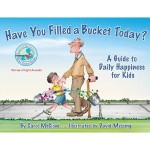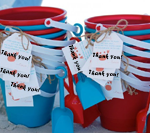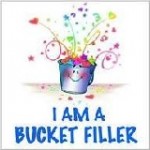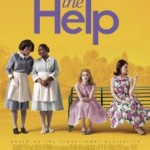 This past summer, I came across a children’s book which was new to me, Have You Filled A Bucket Today? by Carol McCloud. I immediately loved the concept the within the book and began to think about how we could use the analogy of “bucket fillers” and “bucket dippers” within our school. I decided to purchase a book for each primary class (we have 10 classes from gr. 1 -3) and a plastic bucket from the craft store, which I filled with shining pencils, stickers and a bag of goodies. I was determined to get into every primary class within the first week of school, read the story to the children, do a follow-up lesson with them, share the contents of the bucket and then leave them with the following writing task, “Today, I filled a bucket by….” They were to place their responses in the bucket, with the intent of sharing them with me during my subsequent visits. For those of you who can appreciate being in a large elementary school, with over 750 students, you can imagine what the first week of the school year entails. For me this year, the highlight of each day was looking forward to spending time in each of the those classes. The busyness of the office was just going to have to wait until I got back there. Fortunately I work with a tremendous administrative team, who capably held down the “fort” as I enjoyed sharing the book and spreading the message.
This past summer, I came across a children’s book which was new to me, Have You Filled A Bucket Today? by Carol McCloud. I immediately loved the concept the within the book and began to think about how we could use the analogy of “bucket fillers” and “bucket dippers” within our school. I decided to purchase a book for each primary class (we have 10 classes from gr. 1 -3) and a plastic bucket from the craft store, which I filled with shining pencils, stickers and a bag of goodies. I was determined to get into every primary class within the first week of school, read the story to the children, do a follow-up lesson with them, share the contents of the bucket and then leave them with the following writing task, “Today, I filled a bucket by….” They were to place their responses in the bucket, with the intent of sharing them with me during my subsequent visits. For those of you who can appreciate being in a large elementary school, with over 750 students, you can imagine what the first week of the school year entails. For me this year, the highlight of each day was looking forward to spending time in each of the those classes. The busyness of the office was just going to have to wait until I got back there. Fortunately I work with a tremendous administrative team, who capably held down the “fort” as I enjoyed sharing the book and spreading the message.
On the second day of my “bucket -tour” as my secretary aptly named it, I was thrilled to hear one of our grade one students say, “Last night at the dinner table, my brother ( a grade three student who had heard the story the day before) said that I was filling his bucket by sharing the Wii game.
was thrilled to hear one of our grade one students say, “Last night at the dinner table, my brother ( a grade three student who had heard the story the day before) said that I was filling his bucket by sharing the Wii game.
 Many of the classes have created large Thank You posters and they are displayed in my office. One class drew a large bucket and each student filled in a Post-it note with how I fill their buckets each day.
Many of the classes have created large Thank You posters and they are displayed in my office. One class drew a large bucket and each student filled in a Post-it note with how I fill their buckets each day.
When we meet as a Primary division at the end of the month, the classes will bring their buckets and we’ll share some of the stories. We will use the buckets throughout the year in a variety of other ways. I’m hoping the students will be generating ways to use their buckets.
 As we are dealing with issues on the yard and in the classroom, we are asking students, “Are you filling someone’s bucket or being a bucket dipper?” Although I realize that simply reading a book and creating common terminology is not going to change the culture of a school over night, I believe that we are heading in the right direction.
As we are dealing with issues on the yard and in the classroom, we are asking students, “Are you filling someone’s bucket or being a bucket dipper?” Although I realize that simply reading a book and creating common terminology is not going to change the culture of a school over night, I believe that we are heading in the right direction.
So, my question for today is…
How are we filling the buckets of our students, our colleagues, our parent communities?
Come write with me
Sue






